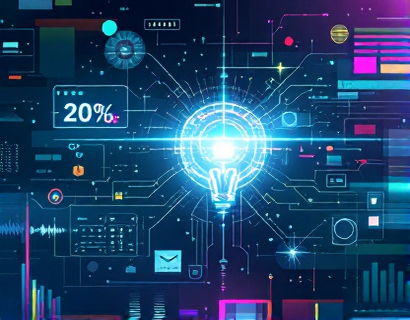Crypto and AI: Catalysts for Next-Gen Digital Transformation in Ucosystems
The integration of cryptocurrency and artificial intelligence (AI) is revolutionizing the tech ecosystem, paving the way for a new era of digital transformation. This synergy is not just about combining two advanced technologies but about creating a powerful force that enhances connectivity, drives growth, and elevates user satisfaction. In this article, we delve into the transformative impact of this integration, exploring how it is reshaping the digital landscape and opening up unprecedented opportunities for innovation and user engagement.
The concept of the tech ecosystem has evolved significantly over the years. Once a collection of disparate technologies and platforms, it has now become a interconnected network where various components work seamlessly together. This ecosystem is the backbone of modern digital experiences, encompassing everything from software and hardware to data and user interactions. The introduction of cryptocurrency and AI has further accelerated this evolution, bringing about a paradigm shift in how we perceive and interact with digital technologies.
Enhancing Connectivity
One of the most significant benefits of integrating cryptocurrency and AI is the enhancement of connectivity within the tech ecosystem. Cryptocurrency, with its decentralized and transparent nature, provides a robust foundation for secure and efficient data exchange. AI, on the other hand, acts as a intelligent mediator, optimizing the flow of information and ensuring that connections are not only secure but also highly efficient.
For instance, blockchain technology, the underlying infrastructure of most cryptocurrencies, ensures that transactions are immutable and verifiable. This transparency reduces the risk of fraud and enhances trust among users. AI algorithms can further optimize this process by predicting and managing network congestion, ensuring that data flows smoothly and quickly. The result is a more connected and reliable tech ecosystem where users can interact seamlessly across various platforms and devices.
Driving Growth
The combination of cryptocurrency and AI is a powerful driver of growth within the tech ecosystem. Cryptocurrency offers a new paradigm for economic transactions, enabling peer-to-peer exchanges without the need for intermediaries. This not only reduces costs but also opens up new markets and opportunities for businesses and individuals alike. AI, with its ability to analyze vast amounts of data and provide actionable insights, helps businesses make informed decisions and innovate at a rapid pace.
In the context of the tech ecosystem, this growth is multifaceted. Startups can leverage cryptocurrency to fund their projects and attract investors, while established companies can use AI to enhance their products and services. The synergy between these technologies fosters a culture of innovation, where new ideas and solutions emerge continuously. This dynamic environment attracts talent and investment, further fueling growth and development.
Improving User Satisfaction
User satisfaction is a critical factor in the success of any digital platform. The integration of cryptocurrency and AI plays a pivotal role in enhancing the user experience by providing personalized, secure, and efficient services. AI-driven analytics can help understand user behavior and preferences, allowing for the creation of tailored experiences that meet individual needs. Cryptocurrency, with its fast and secure transaction capabilities, ensures that these personalized services are delivered without delays or security concerns.
For example, in the realm of digital content, AI can curate content based on a user's interests and viewing history, while cryptocurrency can facilitate seamless and secure payments for subscriptions or purchases. This combination not only enhances the user experience but also builds trust and loyalty. Users are more likely to engage with platforms that offer reliable, high-quality services and a secure way to transact.
Innovative Applications
The synergy between cryptocurrency and AI is giving rise to innovative applications across various sectors. In finance, decentralized finance (DeFi) platforms are leveraging AI to create more efficient and transparent financial services. These platforms offer a range of services, from lending and borrowing to trading and insurance, all powered by smart contracts and AI-driven risk management systems.
In the healthcare sector, AI-powered diagnostic tools combined with blockchain-based patient data management are revolutionizing how medical information is handled and utilized. This integration ensures that patient data is secure and accessible only to authorized personnel, while AI algorithms can analyze vast datasets to identify patterns and predict outcomes, leading to more accurate diagnoses and personalized treatments.
In the realm of supply chain management, blockchain technology provides a transparent and immutable record of transactions, while AI can optimize logistics and predict demand. This combination ensures that products move efficiently from production to consumption, reducing costs and improving reliability. For consumers, this means faster delivery times and higher quality products.
Challenges and Considerations
Despite the numerous benefits, the integration of cryptocurrency and AI is not without challenges. One of the primary concerns is regulatory uncertainty. As these technologies continue to evolve, regulatory frameworks are still catching up, leading to a patchwork of rules that can hinder innovation. It is crucial for stakeholders to engage with policymakers to create a balanced and supportive regulatory environment.
Another challenge is the technical complexity involved in integrating these technologies. Developers need to possess a deep understanding of both cryptocurrency and AI to create robust and secure systems. Education and training programs can help bridge this gap, fostering a new generation of tech professionals who are well-versed in these areas.
Security remains a top priority as well. While blockchain technology is inherently secure, the integration with AI introduces new vulnerabilities that need to be addressed. Continuous monitoring and updating of security protocols are essential to protect against emerging threats.
Future Prospects
The future of the tech ecosystem with the integration of cryptocurrency and AI looks promising. As these technologies mature, we can expect even more innovative applications and broader adoption. The convergence of these fields will likely lead to the development of new standards and protocols that further enhance connectivity, security, and efficiency.
One area of excitement is the potential for decentralized artificial intelligence (DAI). DAI combines the decentralized nature of blockchain with AI, creating systems where intelligence is distributed across a network of nodes. This could lead to more resilient and transparent AI systems, reducing the risk of bias and ensuring that decision-making processes are accountable.
Another promising development is the rise of tokenized economies within digital platforms. By using cryptocurrency to represent value within these ecosystems, platforms can incentivize user participation and create more engaging and rewarding experiences. This tokenization can extend to various aspects, from content creation to community governance, fostering a more collaborative and user-driven environment.
In conclusion, the integration of cryptocurrency and AI is a transformative force in the tech ecosystem. It enhances connectivity, drives growth, and improves user satisfaction, paving the way for a more innovative and user-centric digital landscape. As these technologies continue to evolve, their impact will only grow, shaping the future of how we interact with and benefit from digital solutions.










































